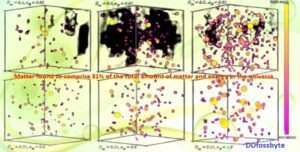In the ever-expanding realm of cosmic exploration, scientists and astronomers have continually sought to unravel the secrets of the universe. From the distant stars that twinkle in the night sky to the enigmatic dark matter and energy that make up the cosmic tapestry, our quest for understanding has led us down a fascinating path. we embark on an exhilarating journey to explore the composition of the universe, with a particular focus on the recent discovery that matter comprises a staggering 31% of the total amount of matter and energy in the cosmos.

An international team of scientists has found that matter makes up about 31% of the total amount of matter and energy in the universe. The remainder is made up of dark energy, a mysterious substance that is thought to be responsible for the accelerating expansion of the universe.
The Marvel of Cosmic Composition
When gazing upon the night sky, it’s easy to become awestruck by the sheer vastness and complexity of the universe. For centuries, humans have contemplated the mysteries of the cosmos, pondering the age-old question: What is the universe made of? The answer to this question has profound implications for our understanding of the cosmos and our place within it.
The Building Blocks of the Universe
To comprehend the recent revelation that matter constitutes a significant portion of the universe, it’s essential to first understand what matter is. Matter, in its most fundamental form, is the substance that makes up everything around us. It encompasses the atoms and molecules that form the basis of all known materials, from the air we breathe to the stars that shimmer in the night.

Quantifying the Cosmic Matter
In the pursuit of unveiling the universe’s secrets, scientists have employed various methods and technologies to quantify the distribution of matter. One of the most groundbreaking discoveries in recent times is the realization that matter constitutes an astonishing 31% of the total matter and energy in the universe.
The Impact of this Revelation
The revelation that matter holds such a substantial presence in the universe has far-reaching implications for our understanding of cosmic dynamics. It reshapes our existing theories and models, prompting us to reassess our comprehension of the universe’s fundamental forces and structures.
Unveiling Dark Matter and Energy
While matter, in its visible and tangible form, makes up a significant portion of the universe, it’s essential to acknowledge the existence of dark matter and dark energy. These enigmatic components, which remain largely elusive to direct observation, continue to intrigue and challenge scientists worldwide.
The Cosmic Balancing Act
Dark matter, which is believed to make up approximately 27% of the universe, exerts a gravitational force that binds galaxies and galaxy clusters together. It’s the invisible scaffolding upon which the visible universe is built. Dark energy, on the other hand, is thought to comprise about 68% of the cosmos, and it’s responsible for the universe’s accelerated expansion.

The Quest for Understanding
The discovery that matter comprises 31% of the universe is a testament to human curiosity and ingenuity. It underscores our unwavering commitment to unraveling the mysteries of the cosmos and gaining deeper insights into the forces that govern the universe’s evolution.
Implications for Cosmic Evolution
As we delve deeper into the implications of this discovery, it becomes evident that our understanding of cosmic evolution is undergoing a profound transformation. The interplay between matter, dark matter, and dark energy is a complex dance that has shaped the universe’s past, present, and future.
A Universe Defined by Matter
The recent revelation that matter comprises 31% of the total amount of matter and energy in the universe is a testament to the remarkable progress we’ve made in the field of cosmology. It highlights the central role that matter plays in shaping the cosmic landscape, from the formation of galaxies to the expansion of the universe itself.

In the universe, matter is a combination of regular or ‘baryonic’ matter, which includes stars, galaxies, atoms, and life, as well as mysterious dark matter, composed of yet-to-be-discovered subatomic particles. Cosmologists estimate that only about 20% of the total matter is baryonic, while dark matter constitutes a substantial 80%.
Measuring the mass of a galaxy cluster directly is challenging because most of its matter is dark and therefore invisible to telescopes. To overcome this challenge, the scientists adopted an indirect approach. They relied on the mass richness relation (MRR), which establishes that more massive clusters contain a greater number of galaxies. Since galaxies are composed of luminous stars, the number of galaxies in a cluster can serve as an indirect indicator of its total mass.
The team’s achievement lies in their innovative use of spectroscopy, a technique that dissects radiation into a spectrum of distinct bands or colors. This allowed for precise measurements of the distance to each cluster and the galaxies gravitationally bound to them. In contrast, previous attempts at using the MRR technique relied on less accurate imaging methods, making this new approach a significant advancement.

The study, published in the journal The Astrophysical Journal, used data from the Planck satellite to measure the clustering of matter in the universe. The researchers found that the amount of matter in the universe is much lower than previously thought.

The universe is a tapestry woven with the threads of matter, dark matter, and dark energy, each contributing to the grand symphony of creation. Our quest for knowledge and understanding is an ongoing journey, and with each discovery, we move one step closer to unlocking the secrets of the universe.
